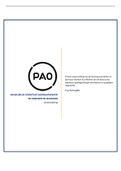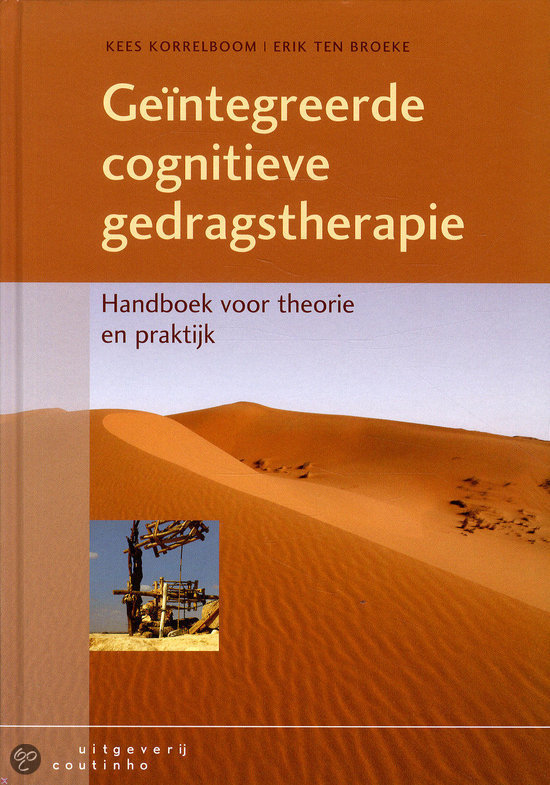In deze samenvatting zijn de theoriepresentaties en
literatuur (boeken & artikelen) van de basiscursus
cognitieve gedragstherapie bij kinderen en jeugdigen
uitgewerkt.
PsycholoogNL
BASISCURSUS COGNITIEVE GEDRAGSTHERAPIE
BIJ KINDEREN EN JEUGDIGEN
Samenvatting
,Inhoudsopgave
Bijeenkomst 1: Van Leertheorie naar Probleemtaxatie .................................................................. 4
1.1 Theoriepresentatie 1 .................................................................................................................... 4
1.2 Theoriepresentatie 2 ..................................................................................................................... 4
1.3 Artikel 1: Ten Broeke & Korrelboom (2004). Bezint voor u begint. . ............................................ 9
1.4 Artikel 2: Brewin, C. R. (2006). Understanding cognitive behavior therapy: A retrieval
competition account. .......................................................................................................................... 9
1.5 Artikel 3: Prins, P., Bosch, J. & Braet, C. (2018). Methoden en technieken van gedragstherapie
bij kinderen en jeugdigen. ................................................................................................................. 13
1.6 Artikel 4: Capita Selecta. Themanummer gedragstherapie ........................................................ 16
1.7 Artikel 5: Ollendick, T.H., & King, N.J. (2011). Evidence-based behandeling voor kinderen en
adolescenten: aandachtspunten en commentaar. .......................................................................... 20
1.8 Artikel 6: Competentieprofiel VGCT ............................................................................................ 22
1.9 Introductie SMART ...................................................................................................................... 23
1.10 De vier leerstijlen van Kolb ........................................................................................................ 24
Bijeenkomst 2: Probleemtaxatie: analyses .................................................................................. 26
2.1 Theoriepresentatie: Probleemtaxatie en analyses...................................................................... 26
2.2 Boek 1: Ten Broeke, E. e.a. (2008). Cognitieve Therapie, de basisvaardigheden. Hoofdstuk 3. (p.
31-64). ............................................................................................................................................... 33
2.3 Boek 2: Korrelboom, K. & Ten Broeke, E. (2014). Geïntegreerde cognitieve gedragstherapie.
Hoofdstuk 4. ...................................................................................................................................... 36
Bijeenkomst 3: Holistische Theorie: Betekenisanalyse en functieanalyse ..................................... 59
3.1 Theoriepresentatie: Holistische Theorie (HT): Betekenisanalyse en functieanalyse .................. 59
3.2 Boek 1: Korrelboom, K. & Ten Broeke, E. (2014). Geïntegreerde cognitieve gedragstherapie.
Bussum: Coutinho. Hoofdstuk 8, 9, 10 en 11 .................................................................................... 64
Bijeenkomst 4: Cognitieve therapie, gedachterapport en socratische dialoog............................... 81
4.1 Theoriepresentatie ...................................................................................................................... 81
4.2 Boek 1: Ten Broeke, E. e.a. (2008). Cognitieve Therapie, de basisvaardigheden. Boom:
Amsterdam. Hoofdstuk 4. (p. 65-98) 33p.......................................................................................... 89
4.3 Boek 2: Korrelboom & Ten Broeke Hoofdstuk 12: Aangrijpingspunt van de behandeling (I);
interventies die sequentiële relaties falsificeren .............................................................................. 90
4.4 Paul Stallard, Denk goed, voel je goed ........................................................................................ 95
Bijeenkomst 5: Gedachterapport deel 2 en gedragsexperiment ..................................................104
5.1 Theoriepresentatie .................................................................................................................... 104
5.2 Artikel 1: Rijkeboer, Over Exposure. ......................................................................................... 107
5.3 Artikel 2: Keijsers (2017). Hoofdstuk 2. Kortdurende protocollaire behandeling van mensen met
een specifieke fobie......................................................................................................................... 111
Bijeenkomst 6: Exposure ...........................................................................................................113
1
, 6.1 Theoriepresentatie .................................................................................................................... 113
6.2 Boek 1: Korrelboom & Ten Broeke, 2014 .................................................................................. 117
6.3 Boek 3: Ten Broeke, E. e.a. (2008). Cognitieve Therapie, de basisvaardigheden. Amsterdam:
Boom. .............................................................................................................................................. 118
6.4 Boek 4: Bennett-Levy, J., Butler, C., Fennell, M, Hackman, A., Mueller, M., Westbrook, D.
(2010). Gedragsexperimenten in cognitieve therapie. Hoofdstuk 1 & 2 (p. 29-88). 59p. .............. 118
Bijeenkomst 7: US/UR herevaluatie technieken .........................................................................121
7.1 Theoriepresentatie .................................................................................................................... 121
7.2 Boek 1: Ten Broeke, E. e.a. (2008). Cognitieve therapie: de basisvaardigheden. Hoofdstuk 6,
Specifieke cognitieve technieken, p. 121 – 156. (alleen het stuk over meerdimensionaal evalueren)
......................................................................................................................................................... 124
7.3 Boek 2: Korrelboom, K. & Ten Broeke, E. (2014). Geïntegreerde cognitieve gedragstherapie.
Bussum: Coutinho. Hoofdstuk 13, p. 481 – 556. 43p. ..................................................................... 124
7.4 Artikel 1: Herstructureren van herinneringen ........................................................................... 134
7.5 Artikel 2: Bögels: bewerken van jeugdervaringen en trauma’s ................................................ 134
7.6 Artikel 3: Schrijftherapie voor getraumatiseerde kinderen en adolescenten. Lucassen .......... 135
7.7 Artikel 4: Van Schagen & Spoormaker (2012). Imaginatie en rescriptingtherapie voor
nachtmerries. .................................................................................................................................. 136
7.8 Artikel 5: de Jongh & Ten Broeke (2011). EMDR: eye movement desensitization and
reprocessing. ................................................................................................................................... 136
Bijeenkomst 8: US/UR herevaluatie technieken 2, COMET ..........................................................139
8.1 Theoriepresentatie .................................................................................................................... 139
8.2 Boek 1: Korrelboom, K. (2011). COMET voor negatief zelfbeeld. Houten: Bohn Stafleu Van
Loghum. (p.1-122). 122p. ................................................................................................................ 143
8.3 Boek 2: Korrelboom, K. & Ten Broeke, E. (2014). Geïntegreerde cognitieve gedragstherapie.
Hoofdstuk 13, p.534-549 (zie literatuur bijeenkomst 7), Hoofdstuk 14, p.560-570 ....................... 146
Bijeenkomst 9: CGT bij ontwikkelingsstoornissen .......................................................................148
9.1 Theoriepresentatie .................................................................................................................... 148
9.2 Boek 1: Korrelboom, Broeke (2014). Geïntegreerde cognitieve gedragstherapie, handboek voor
theorie en praktijk. Hoofdstuk 14.2 (p. 559-588)............................................................................ 157
9.3 Artikel 1: Bruin, R. de. Cognitieve gedragstherapie bij jongeren met een dwangstoornis en
autisme ............................................................................................................................................ 159
9.4 Artikel 2: Prins. Zelfinstructiemethoden en stressinoculatietraining........................................ 161
9.5 Artikel 3: Cladder, Cognitieve gedragstherapie met kinderen en jeugdigen ............................ 164
9.6 Artikel 4: Matthys, W. Gedragsstoornissen bij kinderen – Diagnostiek en behandeling voor de
professional. .................................................................................................................................... 166
9.7 Artikel 5: Steensel: CGT voor angststoornissen bij kinderen .................................................... 171
Bijeenkomst 10: Angststoornissen I: paniekstoornis ...................................................................173
10.1 Theoriepresentatie .................................................................................................................. 173
2
, 10.2 Boek 1: Bennett-Levy, J., Butler, C., Fennell, M, Hackman, A., Mueller, M., Westbrook, D.
(2010). Gedragsexperimenten in cognitieve therapie. Hoofdstuk 3. (p. 89-110). 21p. .................. 181
10.3 Artikel 1: Nauta, M.H., Scholing, a. In Prins, P.J.M., Bosch, J.D., & Braet, C. (2011). Methoden
en technieken van gedragstherapie bij kinderen en jeugdigen. Hoofdstuk 4: anti-angsttechnieken.
p. 320-345, 25p. .............................................................................................................................. 181
10.4 Artikel 2: Bögels & van Oppen (2011). Cognitieve therapie: theorie en praktijk. Hoofdstuk 7, p.
167-196............................................................................................................................................ 184
10.5 Artikel 3: Keijsers (2017). Hoofstuk 4. Protocollaire behandeling van cliënten met een
paniekstoornis met of zonder agorafobie ....................................................................................... 186
Bijeenkomst 11: Stemmingsstoornissen – depressie ...................................................................188
11.1 Theoriepresentatie .................................................................................................................. 188
11.2 Boek 1: Bennett-Levy, J., Butler, C., Fennell, M, Hackman, A., Mueller, M., Westbrook, D.
(2010). Gedragsexperimenten in cognitieve therapie. .................................................................. 193
11.3 Artikel 1: Timbremont, B., Bosmans, G., & Braet, C. (2008). Cognitieve gedragstherapie bij
depressie. Hoofdstuk 13. p 305-324, 20 p....................................................................................... 194
11.4 Artikel 2: Wit, de, C.A.M. (2000). Depressie bij kinderen en adolescenten. Theorie en
onderzoek, diagnostiek en behandeling. Hoofdstuk 10 Behandeling p. 151-174. 23p. ................. 196
11.5 Artikel 3: Hermans, D., & Putte, J., van de (2004). Cognitieve gedragstherapie bij depressie.
Praktijkreeks gedragstherapie. Hoofdstuk 1, 2, 3. (p 7-54). 47 p. ................................................... 200
11.6 Artikel 4: Keijsers, G.P.J., Minnen, van, A., Verbaak, M.J.P.M., Hoogduin, C.A.L., Emmelkamp,
P.M.G., (red)(2017). Protocollaire behandeling van patiënten met een depressieve stoornis.
Hoofdstuk 1, boek 2. ....................................................................................................................... 205
Bijeenkomst 12: Angststoornissen II: Sociale angststoornis .........................................................207
12.1 Theoriepresentatie .................................................................................................................. 207
12.2 Boek 1: Bennett-Levy, J., Butler, C., Fennell, M, Hackman, A., Mueller, M., Westbrook, D.
(2010). Gedragsexperimenten in cognitieve therapie. Hoofdstuk 7. (p. 175-194). 19p. ................ 211
12.3 Artikel 1: Peijnenburg, D., Bögels, S. (2008). Protocollaire groepsbehandeling voor kinderen en
jongeren met angststoornissen: Denken + Doen = Durven. Hoofdstuk 14, p. 325-350. 25p. ....... 211
12.4 Artikel 2: Keijsers (2017). Hoofdstuk 3. Protocollaire behandeling van patiënten met een
sociale angststoornis ....................................................................................................................... 211
3





